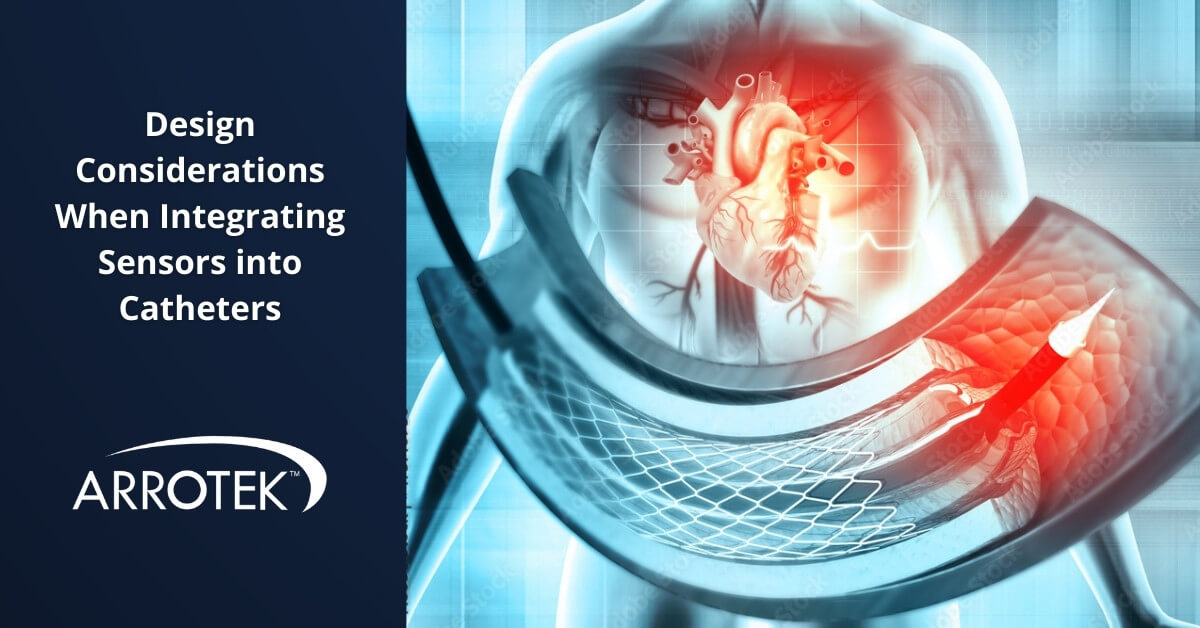Sensors are becoming increasingly critical components of new and innovative catheter products. As sensor technologies develop further, a number of design considerations must be taken into account when integrating sensors into catheters.
A key objective in the design process is to ensure the catheter is safe and performs as intended.
When that is achieved, sensors can significantly enhance a new catheter product, leading to transformed patient outcomes. For example, sensors can provide data that guides medical procedures, enhances decision-making, and helps detect complications and risks. They are also a useful tool to help monitor the progress of treatments.
To achieve performance features like those outlined above, engineers working on catheter design projects will consider the following essential factors.
Type of Sensor
A crucial starting point is the quality of the sensor, as all sensors used in catheters and other minimally invasive medical devices should be of the highest quality.
There are then different types of sensors that should be considered, depending on the application. Pressure sensors are a good example, as there are multiple types of pressure sensors that can be integrated into catheter devices. Examples of the types of pressure sensors that are available include:
- Piezoresistive – a sensor that measures the electrical resistivity during the application of mechanical strain.
- Capacitive – a sensor typically with two plates, one of which is displaced by pressure. This changes the electrical capacitance which can then be measured.
- Piezoelectric – a sensor that measures piezoelectricity, a charge that is created when mechanical stress is applied to certain materials.
Size and Shape
The size and shape of the sensor are also essential design considerations. Specifically, the sensor should fit safely in the catheter without negatively impacting performance, effectiveness, or integrity.
For example, there should be sufficient space inside the catheter after the addition of a sensor for the device to function as intended. Size and shape are especially important considerations in microcatheters.
Sensor Material Considerations
The materials used to manufacture sensors must be suitable for use inside the body with minimal risk of adverse outcomes. As a result, material biocompatibility is an essential consideration during the catheter design process.
Other considerations include ensuring the materials used in the sensor are compatible with the materials used in other components of the catheter. It’s also important the sensor’s materials can cope with relevant temperature, pressure, and other environmental factors related to the intended use of the catheter.
The materials used to make the sensor might also need to be compatible with the drugs or other fluids that will flow through the device, especially if the sensor will come into contact with those substances.
Elasticity is also often an important consideration in relation to materials, particularly to ensure the sensor is capable of the movement required in certain catheter devices that need to navigate tortuous vasculatures.
Catheter Design
The design of the catheter itself is also an essential consideration when integrating sensors. This includes the positioning and method of integration, as well as how sensors interact with other components. Interference, such as bodily fluids impacting the quality of data produced by the sensor, must also be minimised as much as possible.
Environmental Considerations
It’s important to consider the sometimes-extreme conditions that catheters must cope with while inside the patient’s body. Factors that should be considered include:
- How the sensor reacts to extreme conditions.
- The impact those extreme conditions have on the quality of the data produced by the sensor.
- How the extreme conditions might change how the sensor interacts with the catheter’s other components.
Leads
Leads are often an essential component of sensor technologies, but the length and nature of the lead can negatively impact the catheter’s performance. At a base level, leads need to be short enough to avoid negative performance impacts while long enough to capture the required measurement.
Sensor Housing
Some sensors are designed with housing to provide protection during procedures and enhance the component’s reliability and durability. Sensor housing is especially common with pressure sensors and in devices where it is important to minimise electromagnetic interference.
Voltage Supply
The operation and accuracy of sensors depend on having a consistent voltage supply.
Calibration
Sensors used in catheters need to be properly calibrated. This often takes place as part of the manufacturing process and is critical to the catheter performing accurately and as intended. Calibration processes must be considered during the product’s design.
The Future of Sensors in Catheters
While significant steps have been taken, there is still considerable potential for sensor technologies to further transform medical devices, medical procedures, and the way patients are diagnosed and treated. There are also major advances being made in the capabilities of sensor technologies, especially in relation to miniaturisation and wireless capabilities.
At Arrotek, we are excited to work in this field of minimally invasive medical device design as we continue to integrate the most advanced sensor technologies into new catheter products for our clients. Get in touch to find out more.





